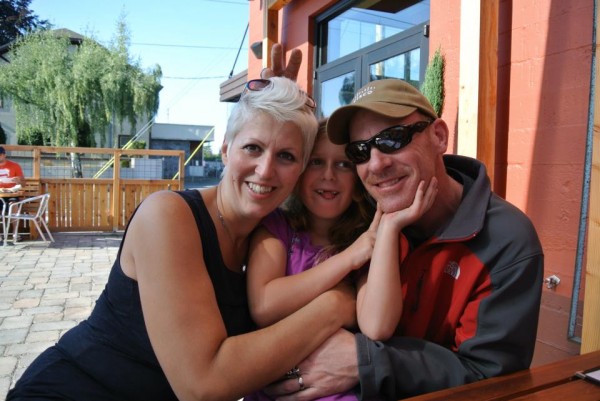Uncategorized
McAuley High School Students Make Cards Of Courage

Laura Hils makes a Card of Courage at McAuley High School with junior Kendra Frey behind her. Photo credit: Kathy Dietrich
What a neat way for youth to make a difference. Students in McAuley High School’s Key Club made 40 Cards of Courage – handmade signs that are brightening the days for residents of Brookdale Place of Finneytown. Brookdale Place is a senior living community for those who need help with routine daily life skills, and those who need care for Alzheimer’s and dementia.
“I thought about people who might need a smile – people who were struggling with something, such as health, loneliness, war, poverty, etc.,” said Junior Laura Hils, the brainchild behind the project. “These cards are meant to bring them courage and brighten their day. At the same time, it brightens the days of the students making the cards.”
Once a month student volunteers gather to make cards and signs to give to others. In addition to the signs at Brookdale Place, they have made cards for homebound parishioners of the St. Bartholomew parish and next month they will make cards for the military.
Finding Strength To Fight Cancer
I want to thank Cameron Von St. James for sharing his family’s story of courage and fortitude in battling cancer.
My wife, Heather has said many times that it is hard for her to imagine what I went through as her caregiver after she was diagnosed with mesothelioma. We have not talked extensively about the experience, but I hope by writing my story, I am able to share more with her and anyone else currently struggling through a tough fight with cancer.
It was three months after the birth of our only child that we got the news. Mesothelioma was a term that brought fear and uncertainty into our lives during a time where we had only been feeling joy and excitement about the future of our new little family. When the doctor informed us that my wife had cancer, I felt overwhelmed, but the immediate need to make critical life decisions forced me to focus.
My first thoughts after hearing the diagnosis were full of rage and anger. I was immediately angry at the world for putting my family in this cruel and unfair situation. I didn’t know how to harness the feelings. There were times when my communication with others was laced with profanity and anger. Eventually, I learned to control the fear that was overwhelming me. I knew that my wife and daughter needed me to be strong. I did not want them to sense my fear, as real as it was. My wife relied on me to be her rock of stability and optimism, and in time I was able to become that.
After the diagnosis, my workload included a long to-do list that ranged from work requirements to travel arrangements to taking care of my wife, my daughter, our home, the list seemed endless. I taught myself how to prioritize, so my focus was on the vital tasks. We were blessed with a strong support system. Many people offered help that I quickly learned to accept. Even with friends and family pitching in, I still was overwhelmed by the responsibilities, but managed to keep up with them as best I could.
Directly following her extrapleural pneumonectomy surgery in Boston, Heather was flown to South Dakota to stay with her parents and Lily, who had been staying there during the operation. Heather needed constant care as she recovered from her surgery and prepared for the next phase of her treatment, and I would not have been able to give her the care she needed while working full time to support us. Therefore, we made the difficult decision to be apart for those two months while she recovered. During this two-month period, I only saw Heather and Lily once.
On one Friday after my workweek ended, I drove 11 hours through a snowstorm to spend time with my family. I arrived Saturday morning, so I had the weekend to rest and see them. Sunday afternoon I was back in the car for the 11-hour trip home. It was hard to be away from them, but it was the choice that made the most sense. I don’t have regrets about this decision. It was just one of many difficult choices I made, but I was glad were had options available.
If I learned anything from this difficult time, it was to accept offers of help from other people who cared. I also learned to never regret or second guess the tough decisions that cancer forced us to make. I could take comfort in the fact that we were able to make choices even if they were hard ones. Being able to plan put us in control in an uncertain time. Despite an overwhelming set of odds, Heather made a full recovery. Six years after the initial diagnosis, she is still healthy. I hope that our story of triumph and struggle will help others battling cancer.
Learn About Downtown Cincinnati’s Dog Park, Fido Field
Please visit my pet blog, My Sidekick and Me, to learn how one man’s determination made it possible for downtown Cincinnati to have Fido Field play area for dogs…and their humans. Please click here.
Pet Dominance: Myth of Fact?
For the answer, please read my post in My Sidekick and Me.
My Thoughts On Positive Reinforcement Vs Dominance In Training
NOTE: I have a new pet behavior blog located at http://www.SoMuchPETential.com/blog. Thanks!
(This is a past Hyde Park Living column.)
People I meet around town are always surprised when I have negative reaction to Caesar Millan. And, it is that surprise that is the very reason why I want to share another view…one on the power of positive reinforcement and the importance of understanding behavior.
To those who believe it is important to be the alpha dog or pack leader, to assert your dominance, I’ve got to ask. How  does it help to foster a love of learning in your pet?
does it help to foster a love of learning in your pet?
One of Ceasar’s strategies for dealing with unwanted behaviors such as fear or aggression (or fear induced aggression) is a technique called flooding. Let me explain. Flooding is a form of training in which the animal is exposed to an aversive stimulus with no possibility of escape until the stimulus no longer arouses anxiety or fear. But can you imagine the level of anxiety and discomfort it causes the animal in the process? It is either sink or swim basically.
Here is an example of how I have seen Caesar work with a dog that exhibits strong aggressive tendencies to children on the street (this would be described as showing his teeth, snarling, having a tense body, and even biting if given the opportunity). He brought the dog on a leash to the sidewalk and had children ride their scooter past the dog, holding it down while the dog struggled and struggled until finally the dog stopped tensing up.
Television viewers saw it as the dog who learned to be submissive and calm. I cringed. Animal behaviorists have another word for it…learned helplessness. Learned helplessness occurs when an animal is repeatedly subjected to an aversive stimulus that it cannot escape. Eventually, the animal will stop trying to avoid the stimulus and behave as if it is utterly helpless to change the situation. Even when opportunities to escape are presented, this learned helplessness will prevent any action.
An example of learned helplessness that you may be able to relate to is Jaycee Dugard, who stopped trying to escape her kidnapper, abuser and father to her children after she realized it would do her no good to try. Yes, she learned how to be calm but what an extreme price to pay for it.
Think about yourself. If you were terrified of tarantulas and someone thought the best way to get you over your fear was to tie you down and cover you with the spiders until you finally quit squirming…how would that make you feel about overcoming fears? How would you feel about the person who wanted to do that to you? Do you think you would be more apt or less apt to be able to cope with other fear inducing situations in the future because of it? Speaking for myself, I can tell you I would probably never forget the feeling of total fear that that person subjected me to.
Systematic desensitization is a much more humane, more positive approach to not just overcoming fear, but also to teaching the animal to re-associate the fear-eliciting stimulus into a feel-good eliciting stimulus. (This process is called counter conditioning.) With systematic desensitization, you gradually expose the animal to what is scary to it and the criteria for advancing to the next step is your watching his calm behavior and only moving forward at a pace that does not elicit even the mildest of fear responses. The beauty of this is that the animal is always in total control. And I don’t know about you but I like knowing I have the power to control my situation.


















